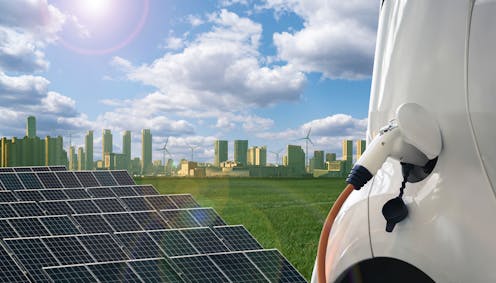
The three most prevalent myths about tackling climate change allege that transitioning to renewable energy jacks up household bills, requires massive amounts of government subsidy and creates mass unemployment. These concerns are all (thankfully) false.
With fellow academics, I studied instances from the past 30 years when governments succeeded in using public investment and regulation to rapidly scale up the deployment of renewable energy technologies like solar panels and wind turbines.
We found that the traditional approach to making energy policy – carrying out cost-benefit analyses, otherwise known as bean counting – tended to impede the roll-out of renewable energy because it misconceived the economy as something static which always operates in an optimal way. This perspective assumes that policy can do little to disrupt the structure of existing markets. The meteoric rise of entirely new sectors over the last decade, such as the global electric vehicle market and offshore wind, show that policy can in fact drive radical changes.
It’s time to debunk the myths which are holding back the transition from fossil fuels.
Myth one: decarbonisation will make electricity expensive
Subsidising low-carbon technology is an investment, not a cost. A recent study suggested it is an opportunity for the global economy with a potential return of US$12 trillion.
Government policies, like offering research and development grants to companies experimenting with more capacious batteries or loan guarantees for firms developing riskier technologies such as concentrated solar power, create an incentive for private companies to invest in new ventures too.
Investment eventually creates a tipping point in the market when the natural choice for investors or consumers shifts from a dominant technology like fossil fuel to an upstart one, like renewable energy, because the latter is suddenly cheaper or more profitable than the former. Once this happens, there can be an exponential growth in the deployment of these new technologies. This has already happened: the plunging cost of generating electricity from solar and wind power caused rooftop solar panel installation rates to soar across Europe alongside investment in large offshore wind farms.

As more of these technologies are deployed worldwide, manufacturers can afford to build larger factories to service growing demand. Coupled with new supply chains, routes to market and the insight gained from making lots of a particular product, the costs of manufacturing drop dramatically. Making one solar panel or wind turbine becomes vastly cheaper over time, which in turn makes the production of a unit of electricity cheaper. These cost curves exist with most new technologies, but not mature ones (like coal power stations) which have been around for decades.
There is also a hefty cost attached to doing nothing about climate change. Recent estimates show a potential global economic loss of US$7 trillion tied to the continued pursuit of growth powered by fossil fuels.
Myth two: renewables need massive subsidies
Renewables over the past three decades have already benefited from government subsidies like feed-in tariffs. These give an additional payment to power companies for the electricity they generate from wind, solar and other renewable sources.
Renewables now compete with and even beat the cost of generating power from fossil fuels. Offshore wind, for example, produces electricity at about a quarter of the current price charged to consumers in the UK – a price set by the wholesale cost of gas. Building new wind turbines no longer relies on subsidies.
Meanwhile the fossil fuel industry benefits enormously from subsidies, receiving almost US$700 billion in 2021 alone. These include governments setting and then subsidising the price of petrol or cooking oil for consumers, giving tax incentives to companies importing or exporting fossil fuels and guaranteeing a minimum level of domestic purchase. These so-called brown subsidies lock countries into ever more expensive sources of energy, as fossil fuels are depleted and require ever more expensive methods such as deep ocean drilling or fracking to extract, which would require subsidies growing forever.

Myth three: jobs will disappear
The transition from fossil fuels in energy systems will shed nearly 3 million jobs in mining, power plant construction and other sectors. But it is expected to create more than 12 million new ones in transport, renewable power generation and energy efficiency by 2030.
Research also suggests that unabated climate change will cause massive job losses on its own, especially in agriculture and construction where extreme weather is likely to wreak havoc. Climate change is already expected to cause US$1 trillion in losses to business over the next five years.
Plentiful green jobs aren’t inevitable, though. Governments must offer skills and employment support to help workers switch from drilling for oil and gas to deploying offshore wind turbines, for example. Such investment could support green jobs which pay 7% more than the average fossil fuel sector job.
The current approach to making climate policy is hindered by the prevalence of these myths. The truth is that investing in a green transition will lower electricity prices, free funding from entrenched fossil fuel subsidies and create new jobs all over the world.
If we continue to fuss about the costs of action then by 2050 there won’t be very many beans left to count.

Don’t have time to read about climate change as much as you’d like?
Get a weekly roundup in your inbox instead. Every Wednesday, The Conversation’s environment editor writes Imagine, a short email that goes a little deeper into just one climate issue. Join the 10,000+ readers who’ve subscribed so far.
Aled Jones receives funding through UK Aid by the UK Government’s Department for Business, Energy and Industrial Strategy (BEIS), and the Children’s Investment Fund Foundation, through the project entitled ‘Economics of Energy Innovation and System Transition’ (EEIST), www.eeist.co.uk. Views represented are the authors’ own and do not represent HMG official views or policy.
This article was originally published on The Conversation. Read the original article.







